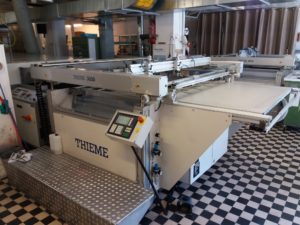 Screen printing refers to direct printing methods, where the ink is printed directly on the printed material (unlike the offset printing method, when the ink is applied to the printed matter through an intermediate-offset surface).
Screen printing refers to direct printing methods, where the ink is printed directly on the printed material (unlike the offset printing method, when the ink is applied to the printed matter through an intermediate-offset surface).
The main difference between the design of stencil machines and others is their printing apparatus. The printing apparatus of the stencil machine consists of a mold holder with a printing plate, a supporting surface on which the sheet material to be printed is arranged; squeegee and watering squeegee (counter-crackle), designed to evenly distribute the ink layer in the form and push it through the printing areas, and the ink-spraying device.
Types of screen printing machines
According to the classification, screen printing machines differ in:
the form of the printing surface:
- flatbed (both surfaces of the printing apparatus – planes)
- flat-print (form – flat, printing surface – cylinder)
- Rotational (and the form, and the printing surface – cylindrical)
the shape of the surface to be printed:
- for printing on flat materials
- for printing on bulk materials
degree of automation:
- manual
- semiautomatic machines
- 3/4 automatic machines
- automatic machines
- production lines
Colorfulness:
- monochromatic
- multicolour
Format:
- small (up to A3)
- medium (up to A2)
- large (up to A1 and higher)
Semiautomatic and automatic screen printing machines
When the tablet machine is working on its table, the printed material is fixedly fixed, over which the printing form is fixed at the time of printing. During operation, the squeegee system with a paint spraying device performs reciprocating motion. During the working stroke, the ink under the pressure of the squeegee is pressed through the open cells of the mold onto the printed material. In this case, the necessary contact of the mold with the printed matter is created, the transfer of ink to the printing elements of the impression, the ink layer breaks through the thickness due to the departure of the printing plate.
The paint passes through the cells of the mold to the printed material and is fixed on its surface. To separate the sheet from the printing plate, a sufficient force is required, determined by:
- the viscosity of the paint;
- the temperature of the paint;
- printing speed;
- force of adhesion of the printed sheet to the printed surface;
- tension of the grid;
The angle of sharpening and the profile of the squeezing surface of the squeegee.
Such a printing apparatus allows printing on a sheet material a different mass, rigidity and thickness, including inflexible. Therefore, it is used in almost all semi-automatic machines, where the printed material is fed and removed manually, as well as in a number of machines equipped with feeders and receiving / output devices.
Advantages of screen printing machines
The advantages of these machines include the ability to work with sealing materials of any rigidity and surfaces up to profiled, as well as the use of high-thickness sealed materials. In this case, the format of the printed material, depending on the type of machine brand, is up to B1 +. ¾ – the automatic machine differs from a semiautomatic device by presence of an automatic feeder.
At the same time, the speed of printing machines in general does not exceed 600-700 cycles / hour (which can correspond to the profile of the output – thick – inflexible – non-absorbent).
If you need a machine that corresponds to higher quality characteristics and speed, you should use flatprint machines: work speed -1000 sheets / hour; accuracy of overlapping repeated runs with well-established technology ± 0,05mm. The thickness of the printed material is almost any stiffness – up to 3cm.
Cylinder screen printing machines
Their printing apparatus also works with a flat printing plate, but a cylinder serves as a support surface for the printed matter. During the operation of the machine, the printing plate carries out reciprocating motion (working and idling); The squeegee does not move. Such a design of the printing apparatus is used in sheet-type automatic machines intended for printing on elastic and soft materials (paper, cardboard, plastic, etc.).
In flat-printing machines with cylinder printing equipment, the printed material is in contact with the printing plate only in the area of the current contact of the cylinder and the printing plate; therefore, the force required for sheet peeling is much less than for machines with a flat design of the printing apparatus.



